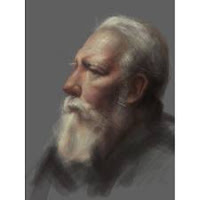I know. C’mon, admit it. You are upset with me. Not one watercolor artist until now?!? Well, I saved the best for last for several reasons. I’ll come right out and say it: no single artist has had a more profound impact on my work than Thomas A. Daly.
I, like Daly, have a huge appreciation for the works of Chardin. Growing up in the sporting life, no woodsman can see the fruits of his labor through Chardin’s eyes and not be moved. Daly quietly picks up the ball and moves farther with this theme. Thomas Aquinas Daly is a master painter.
Why did I save this one for last? First, because Daly is the one artist that I feel moves between watercolor and oil painting in a seamless manner. What I mentioned in yesterday’s post that could be learned from Michael Workman, can also be applied to Daly’s work. His watercolors are made stronger by his oil paintings and if we could ask him, I bet he would acknowledge that his oils were deeply affected by his mastery of watercolor.
I have studied Thomas Daly’s writings and paintings and I have recommended his book Nature’s Quiet Places several times. This brings me to my second point in explaining, “Why is Daly last?” If you read Mr. Daly’s book, you will see that he encompasses all the things we discussed this week.
 |
| Afternoon Olives By Thomas A. Daly |
What is most fascinating about this man is that he lives his art. In no uncertain terms he IS his art. The emotional connections of his daily life – hunting, archery, fly-fishing, carving decoys or making his own skiff – all come together to create his unique vision that is nothing more than an image of himself. Yes, his paintings will live on, and in every painting you see the man.
Please consider Mr. Daly’s book for your collection. The pearls of artistic wisdom are too numerous to count. He gives us real content we can grab hold of and use; big concepts that will carry over to any subject matter you choose. This is why I saved his impact on me until the end.
Let me explain further: what I find so incredibly influential about Daly’s advice is his ability to simplify. His painting style simplifies the landscape into daubs of color, placed in just the right spot on paper or canvas. If you’ve ever felt overwhelmed about where to begin a painting, Daly will sum it up for you nicely: “The subject must be regarded in a purely abstract sense, completely devoid of an identity. Thus, instead of seeing a rabbit or a kettle, I have altered my thought process to envision an array of colored shapes, delicately juxtaposed in almost a mosaic fashion. If successfully translated into paint, that vision will inherently depict the subject’s texture simply as a by-product of good painting.”
Enough said! I hope you will consider his words and his paintings. If taken with sincere appreciation, they will find their way into your own subjects, and maybe someday you will be the “Daly” for another young artist.
Image © Thomas Daly. Content © Mark Kohler Studio.


































